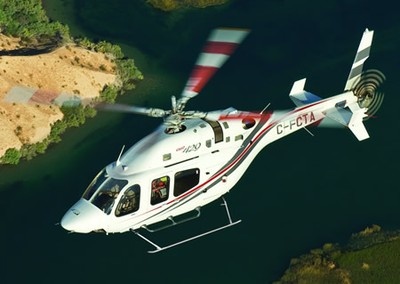Mon, Jan 16, 2012
Company Will Make Similar Case To The FAA, EASA
Transport Canada has approved a 500 lbs. weight increase for the
Bell 429 ... increasing the aircraft's maximum gross weight to
7,500 lbs. “This enhancement was the result of continued
requests from our customers to yield additional performance from
the Bell 429. Our customers told us they loved all the features and
performance the Bell 429 brings to bear but they wanted more range
to take better advantage of the helicopter’s IFR/WAAS
capabilities allowing for a greater safety margin by ensuring the
capacity for necessary fuel reserves for the growing number of
operations in the IFR environment,” said Larry Roberts,
senior vice president for Bell Helicopter’s Commercial
Business.
File Photo

“Outside of the previous certification limit at 7,000 lbs,
all the test data indicated that the Bell 429 would suffer no
technical constraints by increasing the gross weight to 7,500 lbs.
We reached out to the Bell 429’s certification authority,
Transport Canada, and have been working with them for several
months to validate what our data showed. After careful testing,
review and evaluation Transport Canada issued the exemption
approval for the gross weight increase,” Roberts said.
The Bell 429 is certified for Single or Dual Pilot IFR, Cat. A /
JAROPS Performance Class 1 at maximum gross weight; has a
state-of-the-art, fully-integrated glass cockpit; an advanced drive
system that delivers power and superb performance; best in class
WAAS navigation & IFR capability; and is the first helicopter
certified through the MSG-3 process. The additional gross weight
now permits operators to equip the Bell 429 with additional options
including Helicopter Terrain Awareness Warning System (HTAWS), a
radar altimeter, cockpit voice/flight data recorder and strobe
lights.
The increased gross weight directly translates to greater range
and loiter times. With Transport Canada’s approval now in
hand, Bell Helicopter will formally petition the FAA and EASA for
concurrence with Transport Canada on a 500 lbs. exemption to Part
27 with respect to the 7,000 lbs. maximum gross weight limit. We
have deep respect and a very good relationship with both the FAA
and EASA. We believe they will support Transport Canada’s
decision; after all, the exemption would allow for product
improvements that increase operational capability for owners and
operators making it a win/win for everyone,” Roberts
said.
The weight deviation improvement will have the capability to be
retrofitted to the existing fleet through the installation of a
minimal kit that will be available through Bell Helicopter.
Additionally, Bell Helicopter will issue the necessary changes to
the flight manual to correspond with the additional weight
capacity. All of this information will be made available through
Bell Helicopter and its customer support network throughout the
world.
More News
Circle To Runway (Runway Number) Used by ATC to inform the pilot that he/she must circle to land because the runway in use is other than the runway aligned with the instrument appr>[...]
Aero Linx: National Aviation Safety Foundation (NASF) The National Aviation Safety Foundation is a support group whose objective is to enhance aviation safety through educational p>[...]
At Altitude Of About 250-300 Ft Agl, The Airplane Experienced A Total Loss Of Engine Power On November 6, 2024, at 1600 central standard time, a De Havilland DHC-1, N420TD, was inv>[...]
From 2009 (YouTube Edition): Three Hour Flight Was 'Flawless' -- At Least, Until Mother Nature Intervened For anyone who loves the aviation business, this was a VERY good day. Afte>[...]
Also: AMA Names Tyler Dobbs, More Falcon 9 Ops, Firefly Launch Unsuccessful, Autonomous F-16s The Air Force has begun ground testing a future uncrewed jet design in a milestone tow>[...]
 ANN's Daily Aero-Term (05.05.25): Circle To Runway (Runway Number)
ANN's Daily Aero-Term (05.05.25): Circle To Runway (Runway Number) ANN's Daily Aero-Linx (05.05.25)
ANN's Daily Aero-Linx (05.05.25) NTSB Prelim: De Havilland DHC-1
NTSB Prelim: De Havilland DHC-1 Classic Aero-TV: The Boeing Dreamliner -- Historic First Flight Coverage
Classic Aero-TV: The Boeing Dreamliner -- Historic First Flight Coverage Airborne-NextGen 05.06.25: AF Uncrewed Fighters, Drones v Planes, Joby Crew Test
Airborne-NextGen 05.06.25: AF Uncrewed Fighters, Drones v Planes, Joby Crew Test



